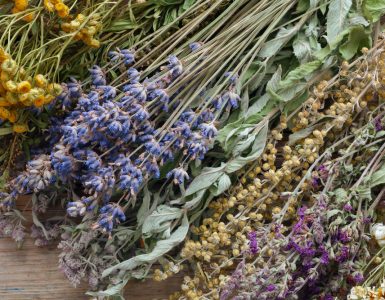(echinacea angustifolia, echinacea purpurea, echinacea pallida)
Botanical family: Asteraceae/ Compositae
Parts used: Root, rhizome, the aerial parts of purpurea variety are also used
Main active ingredients: Echinacosides, alkamides and polysaccharides
Actions: Anti bacterial, anti-viral, immune boosting, antiviral, antiseptic, digestive, analgesic
Good for: Colds, coughs, flu, infections, wounds and inflammations
Available forms: Tincture, tablet, tea
Also known as the purple or prairie coneflower, echinacea (pronounced ek-in-nay-sha) is a wild flower with daisy-like purple blossoms. It is native to the grasslands of Central America and is usually grown in the UK as a garden plant. The name echinacea is derived from the Greek word for ‘prickly hedgehog’ referring to the sharp pointed scales on the dried flower heads. Three main species are used medicinally: angustifolia, purpurea and pallida.
History of Echinacea
Echinacea was used for centuries by Native American Indians to heal septic wounds and snake bites. The plant also became a favourite among European pioneers in America and their doctors for treating infections. According to one 19th century source it was used as a ‘remedy for more ailments than any other plant.’
Like many medicinal herbs, echinacea fell out of favour with the advent of modern antibiotics. But the last decade has seen it grow in popularity as a safe and powerful immune system booster in the fight against colds, flu and other infections.
Overall, studies suggest that if echinacea is started as soon as symptoms develop they seem to improve twice as quickly as when not taking echinacea.
Current uses of Echinacea
IMMUNITY
Containing natural substances with antibiotic properties, echinacea helps to kill bacteria, viruses, fungi and other disease-causing microbes. It works by stimulating the production of white blood cells whose job it is to fight infection. It has also been found to boost production of a natural anti-viral substance called interferon which is thought to help surrounding cells stand up to viruses.
WOUNDS AND ULCERS
Echinacea helps to heal damaged tissue and can reduce inflammation making it a useful external treatment for wounds and ulcers.
OTHER USES
Echinacea may also benefit recurrent conditions such as thrush, cold sores and infections of the urinary tract. It is also thought it may help autoimmune conditions such as lupus, multiple sclerosis and rheumatoid arthritis but in these cases it should always be taken under the guidance of a medical herbalist.
How to take Echinacea
You need to take 2-5 ml tincture three times a day or 200mg dried extract three to four times a day.Most experts agree that the best way to use echinacea is as a short-term boost to immunity for two to three weeks when needed.
Watchpoints
If you are taking antibiotics or other drugs for an infection always use echinacea in addition to rather than as a replacement for these medications.You should not take echinacea if you are pregnant or breastfeeding
Try this
Echinacea can be found in EchinaBoost Echinacea Cold & Flu Relief Tablets and EchinaCold Echinacea Cold & Flu Relief Effervescent Tablets – traditional herbal medicinal products used for the relief of symptoms of the common cold and influenza types infections based on traditional use only.






